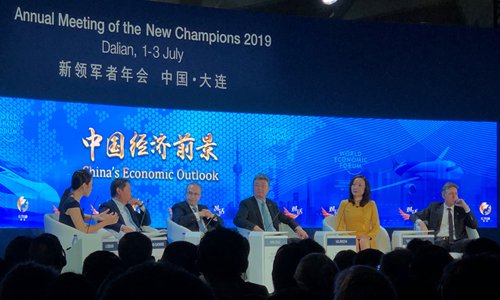What lies ahead for the China-US trade war post-G20?

Illustration: Luo Xuan/GT
On the sidelines of the recent G20 summit in Osaka, Japan, top leaders from China and the US agreed to resume trade talks and not place new levies on Chinese exports. The efforts averted risks of increased trade tensions. A consensus to return to talks indicates a desire on both sides to reach an agreement.
There are several reasons why US President Donald Trump made concessions during the Osaka summit. Trump has incentives to attain a periodical agreement to satisfy his voters and win next year's presidential election. The US economy has already shown signs of reaching the peak of its business cycle and is ready for a plunge. Requests and policy divergence in the political and business arena also led to the outcome achieved in Osaka.
Winning the 2020 election is Trump's primary foreign policy goal. The latest polling figures reveal Trump is far behind Democratic hopeful Joe Biden in approval ratings. However, many politicians feel the prospect of a Biden victory is slim; Trump still commands support from hawkish politicians.
High-ranking US officials have adopted strong attitudes toward the trade talks due to the strong performance of the US economy. US Secretary of Commerce Wilbur Ross has repeatedly said that the trade war has impacted China more than the US.
Ross also believes there is a distance between commitment and enforcement from China regarding intellectual property rights, market competition, and opening up financial sectors. The US government is dominated by hawks, reluctant to make concessions during trade discussions.
Should the US economy experience downward pressure, Washington may soften its attitude on bilateral trade issues. However, China should stay alert despite the resumed trade talks since the tariffs imposed previously are not removed.
The future of trade negotiations will be tumultuous. With fickle policies and declining diplomatic credibility displayed by the Trump administration, the possibility of a trade war flashback, or even upgrade, should not be ruled out.
Competition between China and the US could remain protracted and complicated, and could become the normal state of the China-US relationship.
When dealing with China, the US does not have only one voice.
Though it appears the US hawkish view has dominated public opinion, the demand among politicians and businesses is complex and diversified.
High-tech companies on the US west coast oppose policies that result in an upgraded trade war, suppressing Huawei, and severing technological communications.
Meanwhile, multinational corporations have businesses and interests in China, and have a hard time making their voices heard amid a loud populist chorus.
For these companies, repairing and renovating imbalances that exist in bilateral trade relations suits their interests much better.
US semiconductor companies oppose blocking Huawei. US tech companies have continued to lobby and pressure the government to keep providing devices to Huawei, and selling components to the Chinese company runs in accordance with their interests.
Prior to the G20 summit, The Washington Post, a newspaper more aligned to the Democratic Party, reported three Chinese banks could face the US financial "death penalty."
Rather than applying pressure on China, the report by the newspaper, which has always been anti-Trump, was likely an attempt to humiliate him prior to his meeting with the Chinese leader at the G20 summit. This incident revealed the deep divisions within in the US.
US economy overall is performing well, according to recent statistics, but it has revealed signs of climaxing. Real estate prices in major cities have declined, hinting at a potential economic slowdown.
Trade tensions have influenced the US economy, and the number of Chinese tourists to the US has dropped. Tightened visa policies have hindered academic communication thus affecting related industries.
Despite low unemployment and inflation, US Treasury bonds have seen an inverted yield curve twice this year and the Purchasing Managers' Index reached a new low in May.
Weak employment in the non-agricultural sectors may suggest a tipping point for the US economy could arrive sooner than expected.
The US Federal Reserve has signaled there will be further slowdown for the third quarter if the negative impact from the ongoing trade frictions continues to bear down on the US economy.
Additionally, economic analysis powered by technology and big data has become a new trend. Unlike a few US right-wing politicians advocating the "China threat theory," most US tech firms are optimistic about the prospects offered by the Chinese market and are willing to carve their way out in it.
China and the US, in economic and technological sectors, have great potential for cooperation. The Chinese market has an edge compared with other markets and is attractive to foreign investment.
Regarding China-US relations, we should not be easily influenced by a hawkish US government. Both sides need to seek common ground while reserving differences through negotiations and reach a deal that benefits both sides.
If the trade talks make headway in the future, China can step up its opening efforts in more industries, which would help mitigate disputes and serve as a new engine for the Chinese economy.
The author is chief economist with JD Finance. bizopinion@globaltimes.com.cn



